
The Hawker Harrier was a British experimental biplane torpedo bomber aircraft built by Hawker Aircraft to a specification issued in the 1920s for the Royal Air Force.

The Vickers Type 131 Valiant was a British general-purpose biplane produced by Vickers in 1927, with the intention of replacing the Royal Air Force's Airco DH.9As, but was unsuccessful, with only a single example built, which was sold to Chile.

The Vickers Virginia was a biplane heavy bomber of the British Royal Air Force, developed from the Vickers Vimy.

The Armstrong Whitworth Atlas was a British single-engine biplane designed and built by Armstrong Whitworth Aircraft. It served as an army co-operation aircraft for the Royal Air Force (RAF) in the 1920s and 1930s. It was the first purpose-designed aircraft of the army co-operation type to serve with the RAF.

The Vickers Type 143 or Bolivian Scout was a British single-seat fighter biplane designed and built by Vickers in 1929–1930. Six were built for Bolivia in 1930, which used the survivors in the Chaco War against Paraguay.
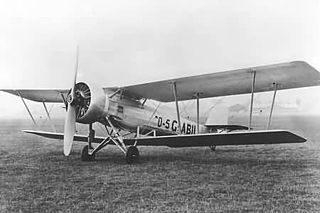
The Vickers Vespa was a British army cooperation biplane designed and built by Vickers Limited in the 1920s. While not adopted by Britain's Royal Air Force, small numbers were bought by the Irish Free State and Bolivia, the latter of which used the type during the Chaco War. One modified Vespa was used to set a world altitude record of 43,976 ft (13,407 m) in September 1932.

The Blackburn B-3 was a prototype British torpedo bomber designed and built by Blackburn Aircraft as a potential replacement for the Ripon. It was unsuccessful, with only the two prototypes being built.

The Supermarine Type 322 was a prototype British carrier-borne torpedo, dive bomber and reconnaissance aircraft of the Second World War. A single-engined monoplane, it was unsuccessful, with only two examples being built. The Fairey Barracuda, built to the same specification, would fill this role.

The Bristol Boarhound was a British army cooperation and liaison aircraft of the 1920s. It was a two-seat biplane with wings of equal span and a steel frame construction with fabric covering.

The Vickers Vixen was a British general-purpose biplane of the 1920s. Designed and developed by Vickers in a number of variants, with 18 Vixen Mark V sold to Chile. A prototype of a version with metal wings was built as the Vickers Vivid. The Vixen also formed the basis of the closely related Venture and Valparaiso aircraft, which were also built and sold in small numbers in the 1920s
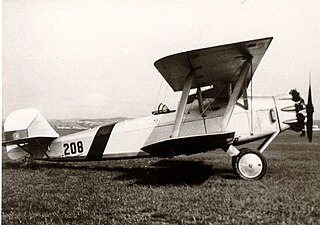
The Vickers Valparaiso was a British light bomber biplane of the 1920s. It was designed by Vickers as a development of its Vixen for export, being sold to Portugal and Chile.
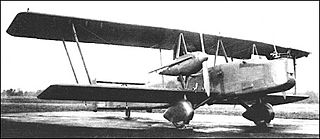
The Vickers Vanox was a British biplane bomber design intended as a successor to the Virginia for the Royal Air Force. Although it underwent extensive development, it was not successful, only a single aircraft being built.

The Vickers F.B.26 Vampire was a British single-seat pusher biplane fighter built by Vickers during the First World War.
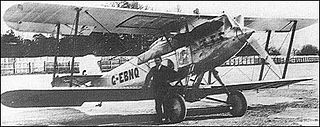
The Vickers Type 123 was a 1920s British single-seat biplane fighter designed and built by Vickers Limited as a private venture. The only Type 123 was later modified into the Type 141 but, not winning any orders, it was scrapped in 1930.

The Armstrong Whitworth A.W.19 was a two/three-seat single-engine biplane, built as a general-purpose military aircraft in the mid-1930s. A newer, monoplane aircraft was preferred and only one A.W.19 was built.

The Vickers Type 151 Jockey was an experimental low-wing monoplane interceptor fighter powered by a radial engine. It was later modified into the Type 171 Jockey II, which had a more powerful engine and detail improvements. Only one was built; it was lost before its development was complete, but the knowledge gained enabled Vickers to produce the more refined Venom.

The Vickers Type 207 was a single-engined two-seat biplane designed as a shipborne torpedo bomber to an early 1930s specification. Structurally innovative, only one was built.

The Vickers Type 253 was a single-engined two-seat biplane general-purpose military machine built to a 1930 government specification. It won a production contract, but this was transferred to the same company's monoplane equivalent, the Wellesley. Only one Type 253 was built.
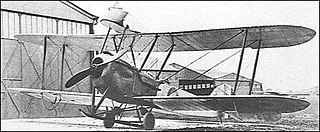
The Vickers F.B.11 was a prototype British three-seat escort fighter of the First World War. A large single-engined biplane, it carried one gunner in a nacelle mounted on the upper wing to give an allround field of fire. Only a single example was completed.
The Vickers E.F.B.8 was a prototype British twin-engined fighter of the First World War. It was abandoned after only one aircraft was built, single-engined fighters being considered to have superior manoeuvrability.



















